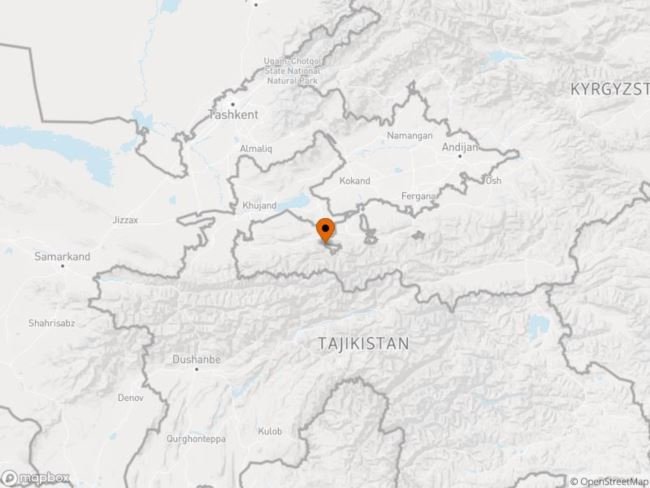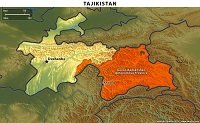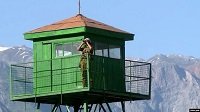
Herald Report

Tajikistan and Kyrgyzstan authorities have signed agreement to ease tension on the borders of the two Central Asian countries after three days’ negotiation at the Chorkuh village of Khoji Alo Jamoat (municipality).
The road that connects the Voruh exclave with the city of Isfara was opened today, after a five-day blockade. The road, previously blocked by the Kyrgyz side, was opened today after the negotiations, resulting in an agreement to prevent conflicts on the border.
Commenting on the results of the three-day talks held in the village of Khoji Alo Jamoat Chorkuh, the Deputy Prime Minister of Tajikistan Azim Ibrohim called them the main achievement that the border guards of the two countries will be removed from the road leading from the Tajik city of Isfara to Vorukh, reported Asia-Plus.
The exclave is a region separated from the main territory of a country and surrounded by other states. The territory is an exclave for the country to which it belongs, and an enclave for the state to which it does not belong, but is surrounded by its territory. Voruh exclave belongs to Tajikistan but surrounded by Kyrgyz territory.
Deputy Prime Ministers of Tajikistan Azim Ibrohim and his Kyrgyz counterpart Jenish Razakov shared the details of the agreement with media on Monday.
Mr Ibrohim called the negotiatio
They have agreed to remove the border guards of the two countries from the road leading from the Tajik city of Isfara to Vorukh, AP reported.
The two sides have also decided to intensify work on the demarcation of the border on the basis of the 2014 agreement.
According to the agreement, the construction of the Aksai-Tamdyk bypass will continue, but it will be used exclusively for driving livestock.
An asphalt road between Vorukh and Khoja Alo will be built around the Ak-Sai village, it reported.

“Everything is spelled out in this agreement, and we only need to step up work on it,” Tajik Deputy Premier Ibrohim told media.
The two countries have agreed to bring to justice the perpetrators of the violence that claimed two Tajik residents’ lives and left over 30 injured, including two Kyrgyz.
“People died, and this must be investigated, and those responsible must be brought to book,” he noted.
Also see Video: https://youtu.be/sYrzeaP6YqE
The prosecutors’ offices of the two countries must act mutually, he stressed.
Kyrgyz Deputy Prime Minister Razakov expressed satisfaction over the agreement.
“I am very glad that we were able to reach an agreement which is important for the local population. We will work on its implementation,” he said.
The two sides agreed to set up a joint team to conduct an invest
ns “successful and a major achievement”, reported AP.
igation into the incident.
It was also agreed to set up teams comprised of the officers of the internal affairs agencies of the two countries to make round-the-clock patrol to ensure public security and strengthen border security.
On March 17, it was reported that the Kyrgyz authorities did not allow the Red Cross ambulance with the necessary medicines to enter the Vorukh jamoat (municipality), a source in the administration of the city of Isfara told AP.
According to him, representatives of the International Committee of the Red Cross brought medicines to victims of the gunfire and stone pelting that took place on March 13 and 14 on the Tajik-Kyrgyz border.
Meanwhile, according to Kyrgyz media reports, the border guards of Kyrgyzstan explained why they did not let the Red Cross car into the Vorukh.
“Since the beginning of the violence in the border village of Aksay and the enclave of Vorukh, local residents were aggressively inclined. In order to ensure the safety of representatives of an international organization, the passage of vehicles with Tajik state numbers has been temporarily suspended,” the Kygyz authorities explained.
On March 16, vehicles with the emblem of the ICRC drove up to the dacha (locality) where locals had blocked road to Aksay, it added.
There ICRC had other cars without identification registration plate. Seeing this, the Aksay residents became suspicious and outraged. In order to prevent the conflict from escalating, the border guards stopped the ICRC representatives from further proceeding and asked them to treat until the situation stabilised.
How the conflict erupted
The violent clashes were triggered by a dispute over road construction in Kyrgyzstan’s southwestern Batken province on March 13 when residents of the Tajik village of Mekhnatabad held a protest against the construction of the Aksai-Tamdyk bypass by the Kyrgyz side because of its close proximity to the border.
However, the Tajik Border Department blamed the residents of Kyrgyzstan for instigating the conflict in order to seize the disputed site.
The clashes started on Wednesday and continued on Thursday after the Kyrgyz authorities attempted to restart work on the road project which crosses Vorukh, an exclave of about 30,000 ethnic Tajiks, in the Ferghana Valley.

Dozens of men on both sides hurled rocks at each other, and several men were wounded. The violence then escalated and two Tajik men were shot dead, and over 30 wounded, the Tajik government said in a statement.
The governments said border guards intervened to prevent further escalation, but just as the two countries’ presidents discussed the incident in a phone call on Thursday last, rock-hurling and shooting started again, leaving a second Tajik dead and two men — one from each side — hospitalized with gunshot wounds.
Tajik border guards also said an angry mob broke into a Tajik family’s house and attacked them, causing serious injuries. The authorities had moved hundreds of women and children out of the Ak-Sai village adjacent to the Tajik exclave, reported Reuters.
Simmering border conflicts
Three former Soviet republics — Kyrgyzstan, Uzbekistan and Tajikistan — have struggled for three decades to agree borders in the Central Asian valley, which is home to several ethnic groups.
While most of the time such incidents are quickly resolved, there is a risk that they will trigger broader violence. In 2010, hundreds were killed and tens of thousands displaced in clashes between ethnic Kyrgyz and Uzbeks in southern Kyrgyzstan.
In trans-boundary Kyrgyzstan and Tajikistan scarcity of pastures and water has led to interethnic tensions, writes Gulzana Kurmanalieva who is a PhD student at Naryn State University, Kyrgyzstan.
A high dependence on water and pasture resources in the border regions plays an important role for this conflict and has motivated violent outbreaks between Tajik and Kyrgyz border communities, writes Ms Gulzana, who is doing her research in the area of pastoralism, institutional analysis of pasture resource management and in material challenges to use and access pasture lands in Central Asia.
Despite policies aimed at enhancing pasture and water management by establishing new institutions after the end of the Soviet Union, multiple conflicts among ethnic communities over pasture and water resources continue to exist. A lack of institutional arrangements leads to unequal pasture and water access and use in the border region of Kyrgyzstan and Tajikistan. This endangers the peaceful co-existence of different ethnic groups in the region as well as sustainable pasture and water use.
She suggests that conflicts result in the deterioration of various forms of assets – social, financial and natural – which constitute the wealth of the Kyrgyz-Tajik border agro-pastoral households.
Many people get tired with continuing conflicts and have started to move to other regions and big cities in order to find a quiet and peaceful life, she notes.
The pasture and water-use conflicts have been continuing for more than 20 years and no effective conflict management strategies have been incorporated in policy documents concerning agro-pastoral areas, she noted.
She makes two recommendations in order to manage the current situation in border areas: Interventions by both governments are needed to strengthen institutions in the two sectors and to increase capacity building in resource management, promote effective inter-ministerial coordination and improve independent monitoring systems.
It is also necessary to improve governance including defining the roles and responsibilities, transparency in decision making on sustainable pasture and water management, and in the use of revenues collected from grazing fees and taxes and involvement of local users and stakeholders.
An intergovernmental agreement is needed to define property rights to access and use water and pasture resources as both communities depend on the same water and pasture resources.
Many experts see the solution of the conflict between Kyrgyzstan and Tajikistan in border demarcation. However, the demarcation and delimitation of borders can be a complicated, troublesome and also an aggressive process when taking into account the location of houses in a chessboard form of border communities. Hence, when trying to find solutions to the conflicts the state members and decision-making bodies of both countries should take the interests of the local citizens into account, Ms Gulzana recommends.

The High Asia Herald is a member of High Asia Media Group — a window to High Asia and Central Asia








